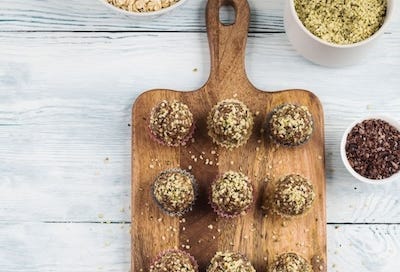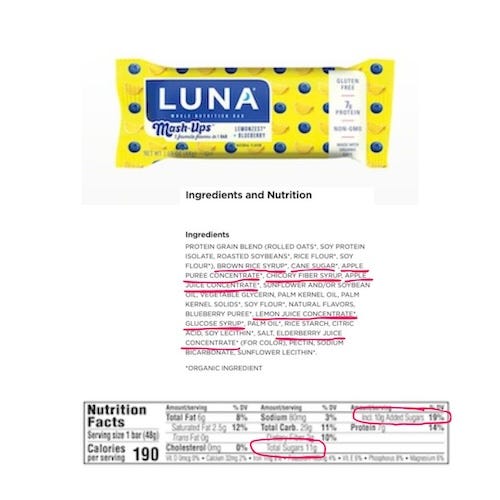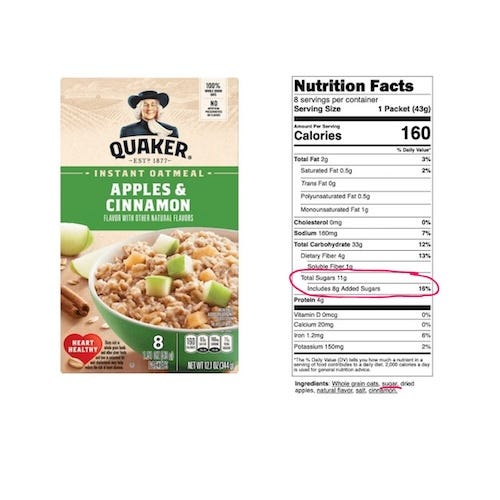Are you trying to eat healthier this year? It may seem impossible to weed your way through the misinformation on food labels today, but I’ve learned a few tricks that might help you out.
I was on a forum the other day where we were talking about reading food labels. Navigating deceptive language can be a full-time job. How do you know what it all means? One woman put it best when she asked:
“How did you learn about this misinformation? So many ingredients for so many different foods and drinks. I don’t even know where to start on where I’m being misled. Even on things I think are healthy and not obvious junk. It’s so overwhelming …”
Take sugar, for example. It’s easy to think sugar is sugar. But it’s just not that easy. Sugar will be listed on labels in a variety of ways depending on the type of sugar it is.
Basic simple sugars include:
Dextrose
Fructose
Galactose
Glucose
Lactose
Maltose
Sucrose
Solid or granulated sugars include:
Beet sugar
Brown sugar
Cane sugar
Cane juice crystals
Castor sugar
Coconut sugar
Confectioner’s sugar
Corn syrup
Crystalline fructose
Date sugar
Demerara sugar
Dextrin
Diastatic malt
Ethyl maltol
Florida crystals
Golden sugar
Glucose syrup solids
Grape sugar
Icing sugar
Maltodextrin
Muscovado sugar
Panela sugar
Raw sugar
Sugar
Sucanat
Turbinado sugar
Yello sugar
Liquid or syrup sugars include:
Agave syrup
Barley malt
Blackstrap molasses
Brown rice syrup
Buttered sugar
Caramel
Carob syrup
Corn syrup
Evaporated cane juice
Fruit juice
Fruit juice concentrate
Golden syrup
High fructose corn syrup
Honey
Invert sugar
Malt syrup
Maple syrup
Molasses
Rice syrup
Refiner’s syrup
Sorghum syrup
Treacle
And this doesn’t include artificial sweeteners or sugar substitutes!
Are you confused yet? Me too!
Why food labels are misleading
As you can imagine, there’s a lot of controversy around food mislabeling. Who do you point the finger at?
It could be the FDA’s fault for having outdated guidelines.
Maybe it’s the fact that the FDA allows words and phrases with misleading health claims to be prominently displayed on product packaging. Does anyone truly think a Baby Ruth candy bar is healthy, even though the ingredients list 4 grams of protein?
Whether logic plays into it or not, misleading words only add to the confusion. How can you trust anything when nothing seems to mean what it should?
The average US supermarket today has just over 40,000 products sitting on its shelves. If you try to get your shopping done in a reasonable time, how are you supposed to navigate the aisles AND select things that are good for you? Especially when labels state things like:
All-natural – the product may not have added color, artificial flavors, or synthetic substances, but natural doesn’t have to equate to healthy.
Sugar-free – this means the product doesn’t contain refined cane sugar. Any of the other forms of sugar are okay.
Gluten-free – gluten is a general term for storage proteins in certain cereal grains; think wheat, barley, rye, and triticale. Nope, the vegetables you’re eating can’t be gluten-free because they’re veggies, not grains.
Made with real fruit – you’ll often see this on things like gummies or children’s juice boxes. What this truly means is it’s made from fruit juice concentrate, which is high in fructose. If you truly want the benefits of real fruit, eat real fruit.
Whole grain – grains like wheat, barley, and oats are edible seeds from grasses. When grain is refined, it’s made into things like white flour or white rice. If you want the benefits of whole grain, be sure the label states “100% whole grain.”
Where to begin
When you know a little more about sugar, you can look for it in everything you buy.
How about a protein bar? Organic? Maybe. But sugar shows up in many different ways: brown rice syrup, cane sugar, and a lot of juice concentrates. That’s 19 percent of your daily sugar allowance in one handy bar.
Or maybe you want a quick breakfast. Oatmeal may seem like a good choice, but with 16 percent of your daily allowance, it starts your day off in more than one way.
I hear you - it’s overwhelming. Do you really need to look at every single thing you’re buying to determine what you should and shouldn’t be eating?
Years ago, I found another way. When the very first Eat This, Not That book made its way onto the bookshelves, I fell in love with the concept.
It’s great advice. And it’s where anybody should start when they want to pay attention to what they are eating.
We all have an internal compass regarding what we should eat. What’s healthy. What’s good for our bodies.
An apple or a candy bar?
A donut or a handful of nuts?
These are obvious choices. You instantly know which is better for you without a lot of thought.
Where things get murkier is when you’re navigating 40,000 products on the supermarket shelves. What brands are better? Which cereal should you choose? Is organic worth the cost?
Where do you start?
Start where you are
How much sugar do you eat in a day? You might be thinking: “Not much” or maybe “I have no idea.”
I suggest you start by finding out how much is in your daily diet. That oatmeal cup you have for breakfast, the sandwich bread you pack for lunch, and the protein bar you grab as a quick snack all add up during the day.
So, track it. Add it up. Count the amount of sugar that goes into your regular diet. (It might surprise you.)
Now, here’s the shocker: experts recommend women eat no more than 25 grams per day, and men consume no more than 36 grams. Per day!
You’ll be shocked at where sugar sneaks in when you start tracking it. Those protein bars were a real eye-opener for me. Cereal - another “wow.” And when you get into things you’ve never considered - crackers, salad dressings, frozen entrees - you’ll be amazed at all the places it pops up. In case you’re wondering, here’s a list:
Low-fat yogurt
Barbecue sauce
Ketchup
Fruit juice
Spaghetti sauce
Sports drinks
Chocolate milk
Granola
Flavored coffee
Iced tea
Protein bars
Premade soup
Breakfast cereal
Cereal bars
Canned fruit
How much of this is sitting on your pantry shelves?
Sugar causes all kinds of health issues:
Weight gain
Higher risk of heart disease
Type 2 diabetes
Increased risk of cancer
Accelerate skin aging
Depression
Drains your energy
Kidney disease
Cognitive decline
Quite honestly, sugar sits at the base of so many diseases, once you’re aware of it, you’ll quickly find ways to decrease it in your own life. (I have. It’s not easy, but you can make changes starting today.)
My biggest recommendation for cutting sugar out of your life
Where people fail is when they think they can make significant changes overnight. Instead, congratulate yourself on realizing that you want to change. And pick the one thing you’re willing to change.
Maybe you’ve eaten protein bars for as long as you can remember. Flip that protein bar over to look at the ingredients - how many grams of sugar does it have?
How can you lower it?
Maybe it’s about finding a higher quality bar.
Maybe it’s about making one yourself.
Or maybe it’s about eliminating it from your life altogether. You don't need the extra calories in the middle of the day anyway.
There isn’t a right or wrong method to this. It’s all about becoming more aware.
And making a better choice.
I often find the simplest solution is moving into your kitchen and making it yourself!
Homemade Protein Bars
1 cup creamy nut butter (peanut, almond, cashew)
⅔ cup hemp seeds
⅓ cup chia seeds
5 medjool dates, pitted
½ cup protein powder
Optional toppings:
Sunflower or pumpkin seeds
Chopped nuts
Cacao nibs
Chopped dark chocolate
Add nut butter and pitted dates to a food processor and pulse to incorporate. Then add hemp and chia seeds, and protein powder and pulse until well combined.
Line a small baking pan with parchment paper. Transfer mixture to the pan and spread with the back of a spoon or flat-bottomed drinking glass to an even layer, about one inch high.
Press optional toppings into the bar. Transfer to the freezer and chill for 10 to 15 minutes to firm the mixture. Remove and cut to size.
Option 2: Roll protein balls. Mix everything in, or roll it in nuts. Have fun. Get creative.
You can store in the refrigerator for up to two weeks, or in the freezer for up to one month.
Let’s get back to wellthy living!
p.s. Did you like this message? It would mean a lot to me if you’d press the ❤️ below if you liked it, left a comment 💬, or shared it with a friend. I’m trying to grow this publication, and I depend on people like you to do so!
And if you’re new here, Welcome! 💐 I’d love to start sharing my message with you if you’re interested in all things plant-powered, proaging, or finding kitchen joy. Subscribe … and then explore my entire archive! Glad to share with you! 🙋🏼♀️











